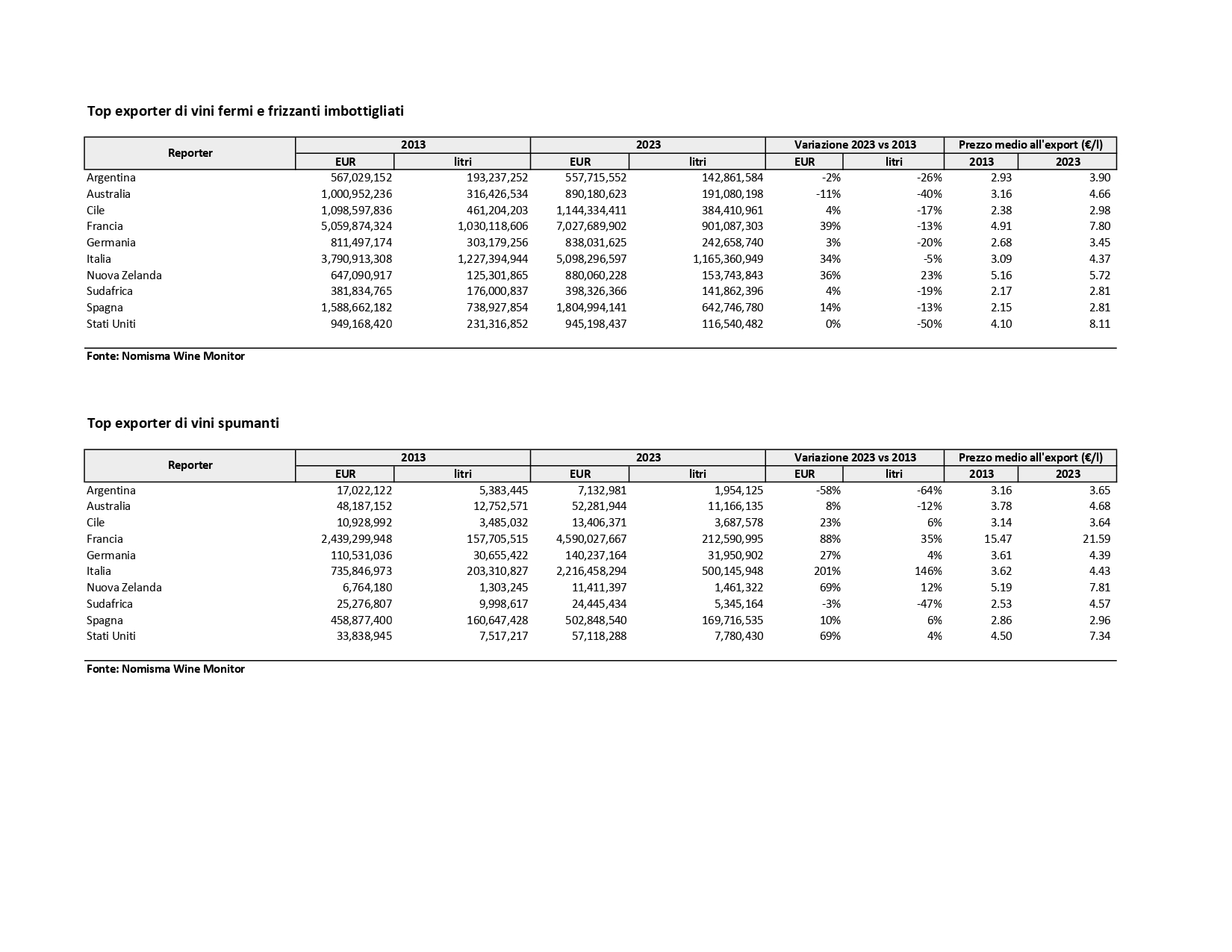The statistics for the decade 2013-2023 analyzed by Nomisma Wine Monitor (courteously provided exclusively to WineReporter.it), photograph the data of the ten largest wine exporting countries in the world. Let’s start with the still and sparkling wines category: all countries have decreased the quantities exported (with the exception of New Zealand). A now trending figure that depends on the decline in consumption of this type at a global level.
The other relevant data – again in the still and sparkling wines sector – is the increase in the average price of wines sold abroad by the 10 Top Exporters. The countries that have grown the most in value, in a decade, are France, New Zealand and Italy. In other words, for France and Italy there has been an upward repositioning of the quantities exported (and this can also be seen in the average price per liter of wine).
For New Zealand, however, the increase in value per bottle was also driven by an increase in volumes. If we consider that this country produces almost exclusively whites (and especially Sauvignon), this data confirms once again the increase in global consumption of white wines at the expense of reds. Analyzing, instead, in detail the differences in ten years of the volumes exported by individual countries, we note that the United States has halved the production finished abroad while keeping the total export revenue almost unchanged. This means that they have been able to best enhance their still and sparkling wines: in a decade the average export price of a liter made in the USA has doubled: from 4.10 to 8.11 euros.
Analyzing, instead, in detail the differences in ten years of the volumes exported by individual countries, we note that the United States has halved the production finished abroad while keeping the total export revenue almost unchanged. This means that they have been able to best enhance their still and sparkling wines: in a decade the average export price of a liter made in the USA has doubled: from 4.10 to 8.11 euros.
France and Italy have defended themselves well. In 10 years the exported volumes have decreased slightly (13% and 5% respectively) but on the other hand the total value of the wines has increased by 39% for France and 34% for Italy. Percentages that translate into an average price per liter that has grown from 4.91 to 7.80 euros (+58.8%) for France and from 3.09 to 4.37 euros (+41.4%) per liter for Italy. This means that in ten years our cousins across the Alps have been able to better valorize their export wines. In short, the winning choice is very clear: fewer exported wines (presumably of higher quality) counterbalanced by the increase in the average selling price abroad.
The data is known and consolidated: we Italians sell more wines abroad, but the French sell less but better, earning over 7 billion euros from exports: 2 billion more than us. This argument – we remember – applies to the category of still and sparkling bottled wines. Bulk wines are not included in this analysis. 
For the ten Top exporters of sparkling wines, more or less the same considerations apply. In the same time period (2013-2023) the statistics of Nomisma Wine Monitor are very explicit.
In this case, apart from Argentina, Australia and South Africa (which produce very little sparkling wine), the top exporters such as France, Italy and Spain have grown in exports also in volume (Italy best performer with Prosecco) in light of a strong growth in the consumption of bubbles at a global level.
In fact, the dizzying increase in the quantities of bubbles exported by Italy is noteworthy, which have increased by 146% (in 10 years) compared to 35% recorded by France. Even greater numbers in value: over 200% for Italy (always driven by Prosecco) against 88% for France. But if we go and read how much a liter of French bubbles sold abroad costs today compared to a liter of Italian bubbles, the result is the opposite. Thanks obviously to Champagne (a type not even remotely comparable to Prosecco) the average price per liter for bubbles in 10 years has gone from 15.47 euros to 21.59 euros per liter for the French (+ 39.56%) while for us Italians the increase has been there but more slight: from 3.62 euros to 4.43 euros per liter (+ 18.28%
It is more France that manages to impose higher average prices on world markets while Italy with Prosecco remains very competitive in a well-defined segment. A success that also derives from its convenience, not being able to be compared in any way with Champagne.
Comparison Italy France on overall export data
In ten years Italy and France have competed for the primacy of world wine exports. If we add the data for the two types (still and sparkling wines plus bubbles), in 2023 Italy clearly prevails in terms of volumes: 1,665,506,897 liters sold abroad (France: 1,113,678,298 liters).
As for the revenue in euros of the quantities mentioned above, the situation is reversed. In 2023, France sold wines abroad for a total of 11.6 billion euros (7.5 billion euros in 2013) while Italy reached 7.3 billion euros in exports this year (the same figure in value that France had 10 years ago). In 2013, the exported value of Italian wine was 4.5 billion euros. It is clear that the value of French wines has grown faster than that of Italian wines in a decade or that, perhaps, Italian bottles are 10 years behind in terms of export potential compared to French ones. In conclusion, if Italian producers want to compete with their cousins across the Alps, they will have to increasingly focus on better quality products and with an average price per liter (and obviously per bottle) higher than the current one.

